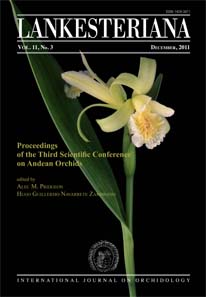The genus Coryanthes: a paradygm in ecology
DOI:
https://doi.org/10.15517/lank.v11i3.18280Keywords:
Orchidaceae, Coryanthes, ecology, pollinationAbstract
Since Darwin, the pollination biology of Coryanthes has fascinated naturalists, but other aspects of its biology are equally interesting. Herman Crüger, Director of the Trinidad Botanical Gardens, first described the pollination process in 1864. He talked about the strong attraction of the floral scent to some kind of Hymenopteran, but the true nature of the reward was not discovered until 100 years later by Dodson and Vogel. Coryanthes species grow exclusively in so-called antgardens. These arboreal communities can reach diameters of 150 cm with the ant nest comprising 80 cm. Both organisms share a destiny because the plant is condemned to death if the associated ant colony dies. The plants offer nectar in extrafloral nectaries and provide a framework for nest construction with their root system, while the ants defend the plants against herbivores and additionally fertilize them with vertebrate feces. This abundant provision of nutrients by the ants allows the plants to grow rapidly. Coryanthes plants raised artificially from seed require about 2 to 3 years to flower. This is perhaps one of the most rapid maturation times among orchids and is more remarkable because the flowers of Coryanthes species are large and massive. They can reach a weight of more than 100 g, the most massive within the orchid family. Capsule ripening is also rapid; most species require only two months to mature a capsule containing around 600,000 seeds. This rapid maturation probably represents an adaptation to this vulnerable habitat. The pollination process is finely tuned with the attraction of one or a few species of male euglossine bees; no other type of insect can effect pollination. A bee that is too large for the passage between the epichile and column will die because it cannot escape the flower and seals the exit. A bee that is too small might pass without effecting pollination. This attraction of one or a few species of bee is the result of the specific preferences of the euglossine males to the chemical composition of the floral fragrance. The different species of Coryanthes have different scents, helping the taxonomist to delimit species that in nature are pollinated by the same bee in spite of color or form variations. All these peculiar ecological adaptations of Coryanthes are evolutionary solutions to survive extreme challenges. The ecology of these plants is so multifaceted that even after years of intense investigation they still hide some secrets.
Downloads
Downloads
Published
How to Cite
Issue
Section
License
According to the Open Access policy promoted by the University of Costa Rica, all the papers published by Lankesteriana are licensed under the Creative Commons copyright and can be downloaded free of charge. The journal holds copyright and publishing rights under the CC BY-NC-ND 3.0 CR license.
Before the publication of the materials submitted by the author(s) in LANKESTERIANA, the author(s) hereby assign all rights in the article to the Lankester Botanical Garden.





